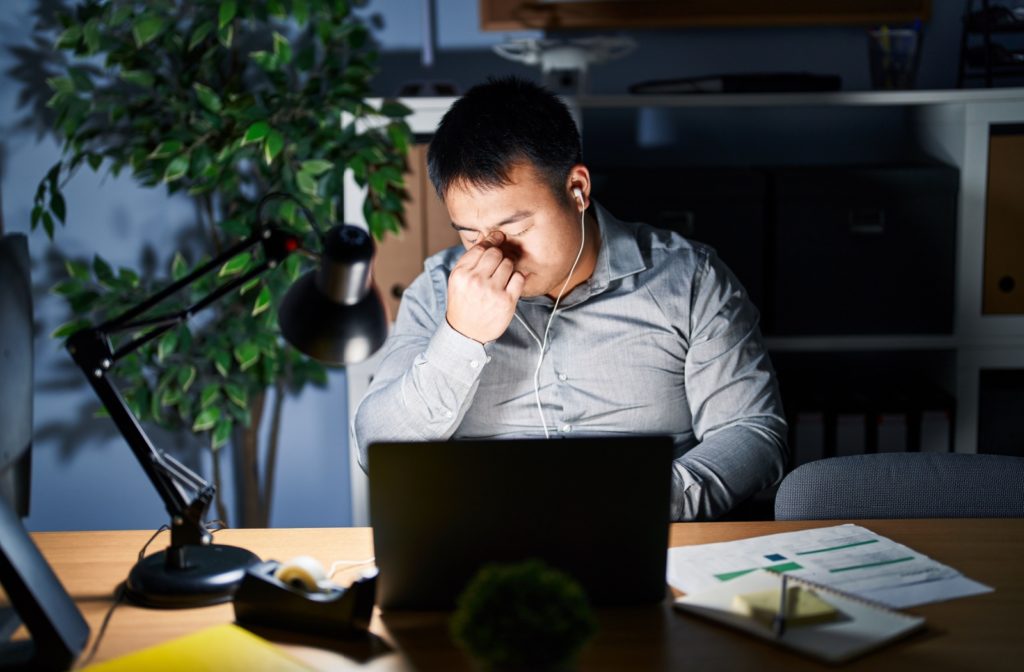With countless hours spent gazing at computer monitors, smartphones, tablets, and other digital devices, our eyes are subjected to continuous stress and discomfort. This is known as digital eye strain. While the symptoms are typically temporary, lasting a few hours to a day, many wonder if eye strain can persist over months.
Addressing this concern requires a deep understanding of the causes, impacts, and mitigation strategies for prolonged eye strain. Eye strain can indeed last for months if the underlying causes are not addressed.
For those seeking expert guidance and solutions to combat the challenges of prolonged eye strain, Richmond Vision Care Optometry provides eye care services to help! With a team of experienced optometrists and high-quality technology, Richmond Vision Care Optometry is dedicated to enhancing your visual health and comfort.
Whether you’re experiencing symptoms of eye strain or looking to prevent future issues, our personalized care and preventive strategies make sure that your vision is in the best hands.
What Is Eye Strain?
Eye strain, or asthenopia, arises from excessive eye use in activities needing prolonged focus, like long driving or extensive screen time in our digital-centric world. This condition, worsened by the shift to remote work and online learning, is increasingly common, and triggers symptoms such as headaches, blurred vision, dry or watery eyes, light sensitivity, and focusing difficulties.
These issues stem from overworked eye muscles and inadequate lubrication, impacting both comfort and sight. Proactively managing eye strain—through regular breaks, suitable lighting adjustments, and consulting eye care professionals—can greatly enhance visual health and overall well-being.
Factors Contributing to Prolonged Eye Strain
While eye strain is usually temporary, lasting only a few hours to a day, certain factors can cause symptoms to persist for months:
Continuous Screen Time
The most common culprit behind prolonged eye strain is excessive screen time without adequate breaks. The blue light from screens can also affect your eyes and disrupt sleep patterns, contributing to further strain.
Improper Eyewear
Using outdated prescription glasses or contacts, or not wearing the necessary corrective eyewear, can force your eyes to work harder, leading to extended periods of strain.
Poor Lighting Conditions
Working in either too dim or overly bright lighting conditions can strain your eyes over time. Ideally, your environment should be well-lit with balanced, natural light or soft artificial light.
Underlying Eye Conditions
Certain eye conditions, such as dry eye syndrome or uncorrected vision problems, can exacerbate the symptoms of eye strain, making it feel like a constant issue.
Lack of Blinking
The diminished frequency of blinking while engaged in activities like reading or using electronic devices contributes to eye strain. Normally, a person blinks between 15 and 20 times per minute, but this rate significantly decreases when our attention is fixed on screens or text. This reduction in blinking leads to dryness and irritation in the eyes.
Managing & Preventing Prolonged Eye Strain
Thankfully, there are several ways to manage and even prevent prolonged eye strain:
20-20-20 Rule
Eye experts recommend the 20-20-20 rule. Every 20 minutes, take a 20-second break to look at something 20 feet away. This practice helps reduce eye fatigue.
Adjust Your Setup
Ensure your computer screen is about an arm’s length away and positioned slightly below eye level. Consider using screen filters to block blue light and adjust the brightness to match your surrounding workspace.
Optimize Lighting
Avoid working under harsh lighting. Use blinds or curtains to control sunlight, and if needed, adjust your indoor lighting to reduce glare and discomfort.
Stay Hydrated
Drink plenty of water throughout the day to help prevent dry eyes. Also, use artificial tears if needed to keep your eyes lubricated
Regular Eye Exams
Visit an optometrist regularly to make sure that your eyewear prescription is up to date and to check for any underlying eye conditions that could be causing or contributing to your discomfort.
Eye Drops
Applying eye drops, like artificial tears, can help mitigate eye strain issues. Consciously reminding yourself to blink more often during concentrated tasks can also aid in reducing eye strain.

The Path Forward
While it’s unsettling to think that eye strain can last for months, understanding the causes and taking proactive steps to mitigate them can significantly reduce the duration and intensity of symptoms. If you’re experiencing persistent eye strain, it’s crucial to consult with an eye care professional who can provide tailored advice and treatment options.
Our expert team is ready to provide you with personalized care and effective solutions tailored to your needs. Secure your slot now and experience the difference professional eye care can make.
Protect your eyes, enhance your vision, and elevate your daily comfort. Book your appointment with Richmond Vision Care Optometry today—because your eyes deserve the best care.


